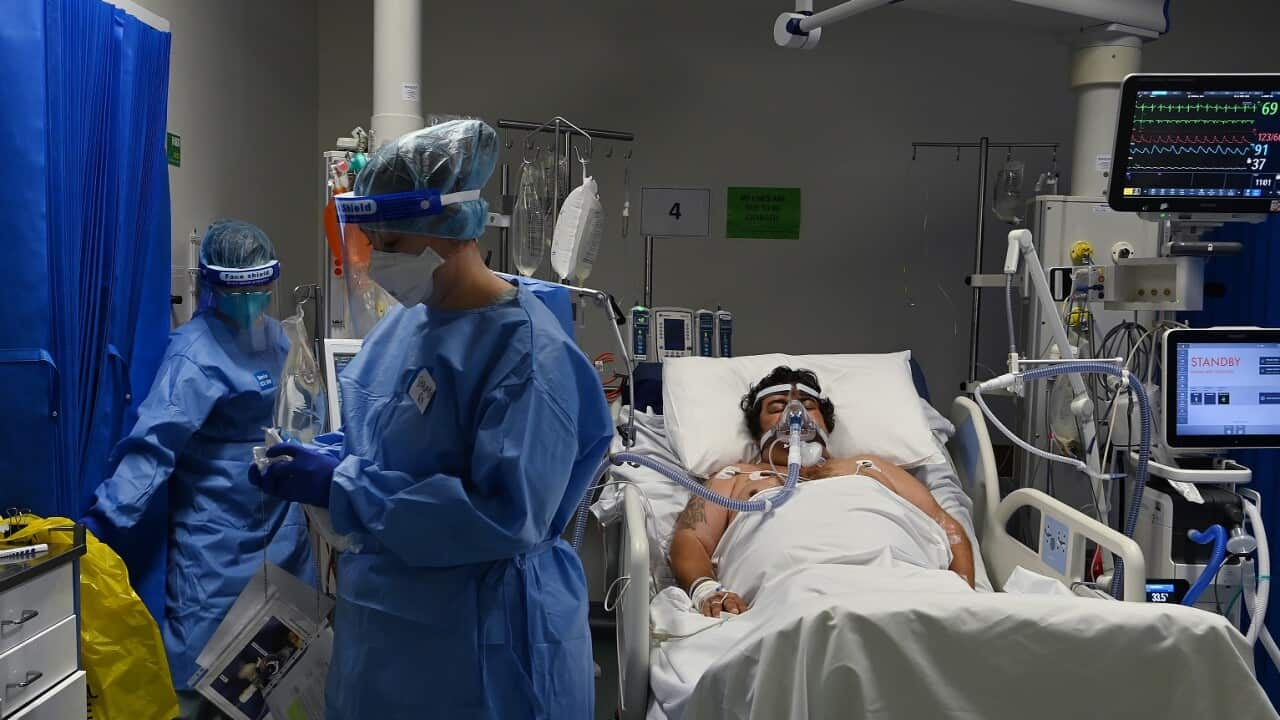Key Points
- Tracy Kelly contracted COVID-19 in March and still has symptoms months later.
- Many others are experiencing the same problem, according to a new study.
One in 10 Australians who got COVID-19 were still suffering symptoms more than three months later, according to a new study.
The also found nearly a third had symptoms for more than a month — equating to just over 14 per cent of the entire adult population in Australia.
Professor Nicholas Biddle, a quantitative social scientist and lead author of the study, said females, young Australians, and those living in middle-income households had the highest probability of contracting COVID-19.
More than 3,000 people were surveyed in August this year as part of the study, which has not been peer reviewed.
“This is a snapshot of how Australians have experienced COVID-19 since early 2020,” Professor Biddle said.

Women and young people are most likely to get COVID-19, according to the ANU study. Source: AAP
"In terms of long COVID, there are some very good studies around the world, which have estimated about 12 per cent of people who've been infected, no matter whether they had a severe infection, or a mild one, ended up with long-term health problems," he said.
He said this survey bolstered the findings of these other studies.
"And that's quite horrific, given the millions of people who've been infected in Australia."
Tracy Kelly, 43, said she was one of those people who didn't believe long COVID existed until she got it herself.
"I used to say, 'long COVID, what a load of crock - that doesn't exist', and karma came back to bite me."
Due to the debate around how long COVID should be defined, the ANU study looked at two groups. The first group had symptoms that started or continued for more than four weeks but less than 12 weeks. The second group - called the post-COVID-19 syndrome group - had symptoms for more than 12 weeks.
Ms Kelly is in the latter group. Having gotten COVID-19 in March, she is still experiencing symptoms including shortness of breath, chest pains and brain fog.
I used to say 'long COVID, what a load of crock - that doesn't exist' and karma came back to bite me.Tracy Kelly
The study found around 10 per cent of people who got COVID had symptoms lasting three months or more. This equated to nearly five per cent of Australian adults.
Women were more likely to report post-COVID-19 syndrome than males (5.5 per cent compared to 4.0 per cent).

Tracy Kelly developed long COVID after first becoming sick in March. Source: Supplied / Charis Chang
Among those who had symptoms for more than four weeks, around 23 per cent said it reduced their ability to carry out day-to-day activities "a lot". About 63 per cent said it reduced their ability "a little".
Ms Kelly was fully vaccinated prior to getting infected but got very sick with COVID-19. She has been taken to hospital in an ambulance four times because of chest pain and trouble breathing.
The Brisbane woman also recently developed postural orthostatic tachycardia syndrome (POTS), a condition that has left her with a high heart rate which gets worse when she stands up, and can leave her feeling dizzy and nauseous.
Prior to getting COVID-19, the mother-of-one said she exercised every day and worked in retail so was always lifting heavy boxes.
"I was the kind of person who couldn't sit still," she said.
"Now I can't do anything, the best I can do now is sit on my recliner chair most of the day, just to rest because the more I'm not active, the better I feel."
Ms Kelly's mental fatigue is so bad she can sleep for 12 hours and still wake up tired. It can also take her four days to complete a crossword puzzle, something she used to finish easily.
"I know what the answer is but I just can't think of it, and they're simple answers."
Hope for better recognition of long COVID
For those suffering from long COVID, the study raises hopes there will be more recognition from authorities about the condition and extra resources.
Jillian Kent, 35, said it had been "very disheartening" to hear Australia's Chief Health Office Professor Paul Kelly dismiss concerns around long COVID.
During a press conference on 30 September to announce the removal of Australia's mandatory isolation measures, Professor Kelly was asked about long COVID and responded that Australia was in a different position to most of the rest of the world.

Chief Medical Officer Professor Paul Kelly's comments about long COVID upset those who are battling the condition. Source: AAP
"None of those things pertain to the Australian situation for most of us."
His words upset many Australians who have long COVID including Ms Kent. She got COVID in January, despite having had two doses of the vaccine, and still suffers from fatigue, vertigo, constant headaches, migraines and other cognitive issues. She has been unable to work full-time and struggles to even do one day a week.
The Brisbane resident said Professor Kelly's comments that long COVID didn't "pertain" to Australia were "completely invalidating to everybody who's experiencing this".
"A lot of people were very upset about that," she said, adding the comments even sparked the Twitter hashtag #pertainstome.

Jillian Kent got COVID in January and has suffered from long COVID for almost 10 months. Source: Supplied / Charis Chang
The most likely groups to catch COVID
The ANU study confirms previous research that shows it's likely nearly half of all Australians have had COVID-19. Around 10 per cent of these people did not experience any symptoms.
The vast majority of Aussies who've had COVID say they've only had one infection but around 11 per cent said they had been infected twice, and 5.4 per cent had it three times or more.
Women and younger Australians are estimated to have higher rates of infection, compared to men and older Australians.
Those who have a Certificate III/IV as their highest educational qualification have the highest infection rates, while those who have a postgraduate degree have the lowest infection rates.
The lowest level of reported infection is amongst those in the lower-middle-income group and those in the lowest-income households in particular.
Most common COVID symptoms
Among people who did get sick, tiredness was the most common symptom.
On average, people had around 10 symptoms, with around three-quarters saying they had a runny nose, sneezing, sore throat, cough and headache.
Among those who were sick for four weeks or more, the most common symptoms were tiredness (experienced by 82.1 per cent) and weakness (58.4 per cent).

Around 5 per cent of Australians who've had COVID say they've been infected more than three times. Source: AAP
Those who had long COVID which had led to restrictions in their ability to carry out day-to-day activities had the lowest level of life satisfaction.
“Of those who experienced COVID-19 symptoms, 40.7 per cent said they experienced low mood," Professor Biddle said. "Our data suggests those who had symptoms for multiple months were impacted the most.
“On the other hand, people who had short experiences with COVID-19 or few symptoms generally didn’t experience a decline in wellbeing compared to those who had not had COVID-19."












